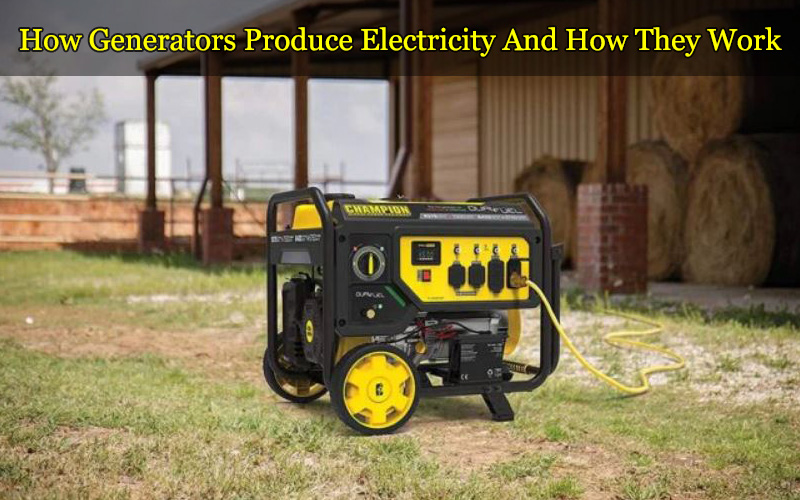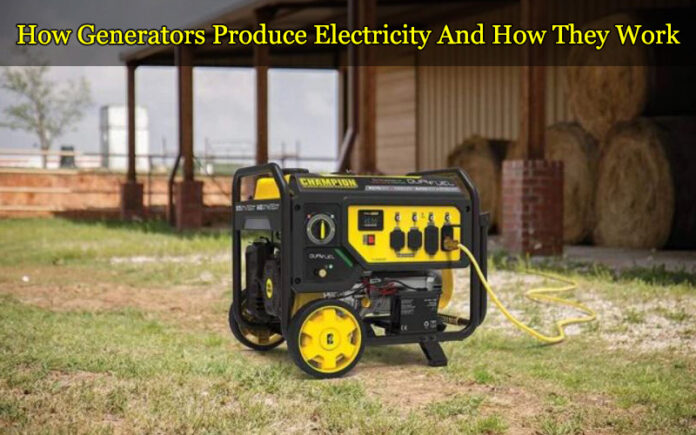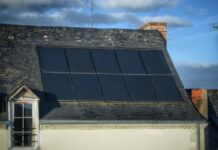Generators are functional appliances that provide electricity during a power outage. Industrial generators can be a primary power source where a local electrical grid is unavailable or inaccessible. Some people use tiny, portable electrical generators to power a few gadgets when camping or going outdoors.
Generators play a crucial role in our modern world by providing electricity when and where it’s needed. Understanding how generators produce electricity and their working principles can help us appreciate their significance.
In this post, we’ll examine the basic ideas that underlie generator functioning and walk you through the process involved in electricity generation.

How Do Generators Produce Electricity?
A generator is a machine that produces electrical energy from mechanical energy supplied from an external source.
Realizing that a generator doesn’t really “create” electricity is critical. Instead, it forces the electric charges in the wire of its windings via an external electric circuit using the mechanical energy provided.
This flow of electric charges represents the generator’s output electric current — compared to a water pump, which induces water flow but does not really “create” the water flowing through it.
The electromagnetic induction principle, which Michael Faraday discovered in the 1830s, is the basis on which the generator works.
Faraday observed that moving an electrical conductor, such as a wire that holds electric charges, in a magnetic field might cause the flow of electric charges mentioned above. The electric current production is due to the voltage differential between the wire’s two ends.
The Main Components of A Generator
The basic parts of a generator fall into the following general categories:
Engine: The generator receives its mechanical energy input from the engine. The highest power output the generator can produce is directly inversely related to the size of the engine.
Fuel System: The fuel tank usually has enough capacity to run the generator for hours. Smaller generators often include a gasoline tank attached to the generator’s base or installed on top of the frame. Building and installing an external gasoline tank for commercial usage could be essential.
Alternator: The component of the generator that creates the electrical output from the mechanical input provided by the engine is called the alternator, sometimes referred to as the “gen head.” It has a collection of fixed and moving pieces enclosed in a housing.
Voltage Regulator: As its name suggests, this part controls the generator’s output voltage.
Exhaust and Cooling System: The generator’s numerous components get heated when used continuously. A cooling and ventilation system is necessary to remove the heat generated during the process. Like exhaust from any other diesel or gasoline engine, the fumes released by a generator include hazardous compounds. Installing a sound exhaust system is thus necessary to eliminate exhaust gases.
Lubrication System: Since the generator’s engine has moving components, lubrication is necessary to maintain longevity and smooth performance over an extended length of time.
Battery Charger: The charger maintains the generator battery’s charge by giving it a precise “float” voltage.
Control Panel: This is the generator’s user interface, with controls and electrical outlet facilities.
The frame or Main Assembly: All portable or permanent generators have unique housings supporting the structure.
The Process Overview of How Generators Work
We can better understand the complexities of power generation by comprehending the fundamentals of a generator’s operation.
Prime mover input: The generator receives mechanical energy from a prime mover, such as a steam turbine, water turbine, or internal combustion engine.
Rotation of the rotor: The generator’s magnet-containing rotor rotates by the prime mover’s mechanical energy.
Magnetic field generation: The magnets generate a revolving magnetic field around the stator as they revolve.
Electric current induction: Through electromagnetic induction, the spinning magnetic field causes an electric current to flow through the stator windings.
AC to DC conversion (if applicable): If necessary, a rectifier may convert specific generators’ alternating current (AC) into direct current (DC).
Transmission of electrical energy: Electrical energy is created and used to power various systems and appliances.
See also: A Glance At Different Types Of PVD Coating
The Importance of Getting The Right Generator Size
Choosing the proper size is the most crucial step in installing a backup or primary generator. Using an undersized machine might strain the system, resulting in the generator cutting out in the middle of the operation, causing an early generator failure, and possibly even harming the attached equipment.
Generally, larger generators are preferable to smaller ones, but they also have certain disadvantages. Installing a generator that produces much more electricity than is required is wasteful. You face the danger of overspending on fuel and harming the linked gadgets.
This wide range of power capacity gives purchasers many options but raises many issues about which generator is best for them. A generator must be correct in size, which includes several aspects and considerations.
In the United States, several generator providers exist, namely Generac, Honda, Yamaha, Kohler, and more. If you are considering a Kohler generator, you might have a question: ‘Can a Kohler generator run continuously?’ It’s essential to consult with a licensed electrician or an experienced supplier when purchasing a generator to get accurate information and guidance tailored to your specific needs.
See also: 8 Tips to Make your Electronics Shockproof for Kids
Conclusion
Generators are essential to our contemporary culture, whether for powering remote places during blackouts, maintaining vital infrastructure, or providing energy during power shortages.
We can decide how to use, maintain, and safely operate generators if we know how they function and generate power. As technology improves, generators also advance, offering dependable and effective power production options for various applications.






















